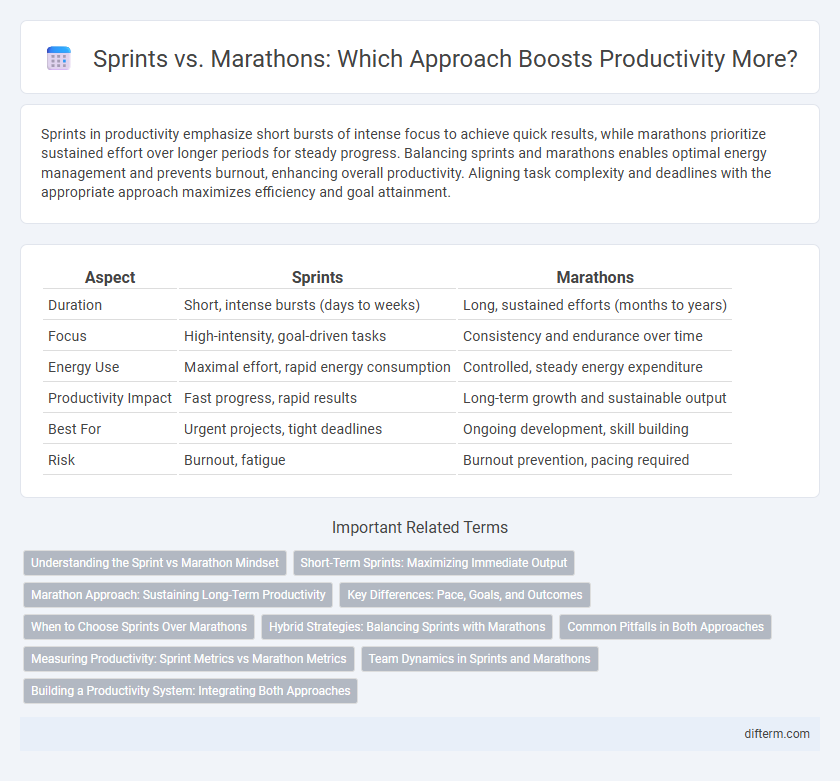Sprints in productivity emphasize short bursts of intense focus to achieve quick results, while marathons prioritize sustained effort over longer periods for steady progress. Balancing sprints and marathons enables optimal energy management and prevents burnout, enhancing overall productivity. Aligning task complexity and deadlines with the appropriate approach maximizes efficiency and goal attainment.
Table of Comparison
| Aspect | Sprints | Marathons |
|---|---|---|
| Duration | Short, intense bursts (days to weeks) | Long, sustained efforts (months to years) |
| Focus | High-intensity, goal-driven tasks | Consistency and endurance over time |
| Energy Use | Maximal effort, rapid energy consumption | Controlled, steady energy expenditure |
| Productivity Impact | Fast progress, rapid results | Long-term growth and sustainable output |
| Best For | Urgent projects, tight deadlines | Ongoing development, skill building |
| Risk | Burnout, fatigue | Burnout prevention, pacing required |
Understanding the Sprint vs Marathon Mindset
The sprint mindset emphasizes short, intense bursts of productivity aimed at quick wins and immediate results, suitable for tasks requiring urgency and high energy. In contrast, the marathon mindset prioritizes sustainable, steady progress over time, fostering endurance and long-term goal achievement. Balancing these approaches enhances overall productivity by aligning effort with project demands and personal capacity.
Short-Term Sprints: Maximizing Immediate Output
Short-term sprints in productivity emphasize focused bursts of intense work designed to maximize immediate output and rapidly achieve specific goals within tight deadlines. By leveraging techniques like time-blocking and Pomodoro intervals, individuals and teams can maintain heightened concentration and energy levels essential for quick, high-impact results. This approach prevents burnout by alternating periods of intense effort with strategic breaks, ensuring sustainable performance during critical project phases.
Marathon Approach: Sustaining Long-Term Productivity
The marathon approach to productivity emphasizes maintaining consistent effort and energy over extended periods, which prevents burnout and promotes sustainable progress. By pacing work evenly and incorporating regular breaks, individuals can enhance focus and resilience, leading to steady achievement of long-term goals. This method aligns with research on cognitive endurance, highlighting the benefits of sustained, moderate intensity work over intense, short bursts typical of sprint methods.
Key Differences: Pace, Goals, and Outcomes
Sprints emphasize rapid, intense bursts of productivity aimed at achieving short-term goals, usually completed within days or weeks. Marathons involve sustained, consistent effort over longer periods, focusing on long-term objectives and endurance. The outcomes of sprints often deliver quick wins and immediate momentum, while marathons cultivate resilience and steady progress toward comprehensive results.
When to Choose Sprints Over Marathons
Sprints are ideal for tasks requiring intense focus and quick turnaround, maximizing productivity during short bursts of energy. Choose sprints when deadlines are tight or projects demand rapid iterations, allowing teams to adapt swiftly to feedback. This method outperforms marathons in high-pressure environments where maintaining prolonged effort can lead to burnout and decreased efficiency.
Hybrid Strategies: Balancing Sprints with Marathons
Balancing sprints with marathons enhances productivity by combining the intensity of focused work bursts with the endurance of long-term commitment. Hybrid strategies optimize energy management and prevent burnout by alternating high-effort phases with sustained, steady progress. This integrated approach leverages short-term agility alongside consistent momentum to achieve complex goals efficiently.
Common Pitfalls in Both Approaches
Sprints often lead to burnout due to intense bursts of productivity without adequate recovery, while marathons risk dwindling motivation from prolonged, monotonous effort. Both approaches can suffer from poor time management and lack of clear goal-setting, causing inefficiencies and missed deadlines. Ensuring balanced energy expenditure and strategic planning is crucial to avoid the common pitfalls inherent in sprint and marathon productivity models.
Measuring Productivity: Sprint Metrics vs Marathon Metrics
Sprint metrics emphasize short-term output, tracking task completion rates, velocity, and immediate goal achievements to gauge productivity in fast-paced work cycles. Marathon metrics focus on sustained performance indicators like consistency, endurance, and long-term progress over weeks or months, measuring how well teams maintain quality and output over extended periods. Combining sprint and marathon metrics provides a comprehensive productivity assessment, balancing rapid results with ongoing efficiency and resilience.
Team Dynamics in Sprints and Marathons
Team dynamics in sprints emphasize rapid collaboration, intense focus, and quick decision-making to achieve short-term goals efficiently. Marathons require sustained communication, resilience, and steady pacing to maintain motivation and productivity over extended periods. Understanding these differences helps optimize workflow by aligning team strategies with project timelines and energy levels.
Building a Productivity System: Integrating Both Approaches
Balancing sprints and marathons is essential for building an effective productivity system that maximizes efficiency and sustains long-term performance. Sprints enable intense focus and rapid progress on short-term goals, while marathons support endurance and steady advancement toward broader objectives. Integrating both approaches ensures a dynamic workflow that adapts to varying task demands, enhancing overall productivity and preventing burnout.
Sprints vs Marathons Infographic

 difterm.com
difterm.com